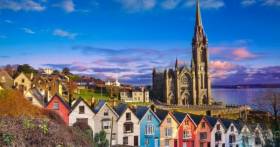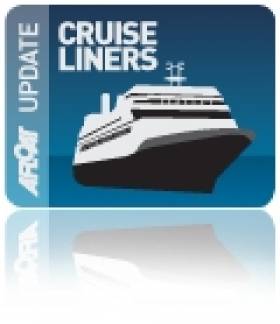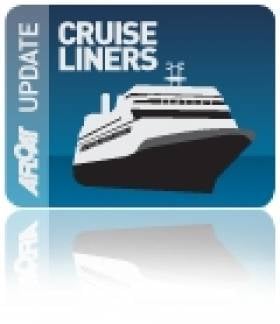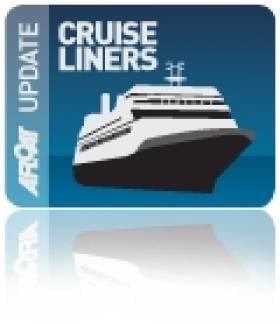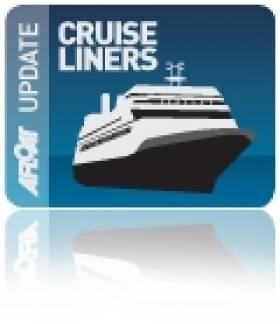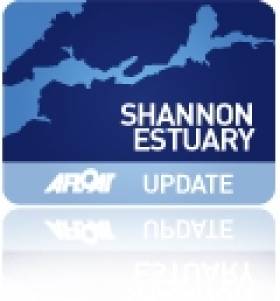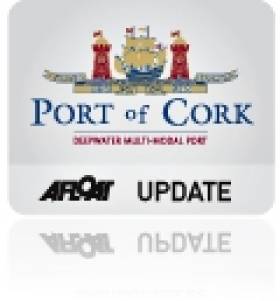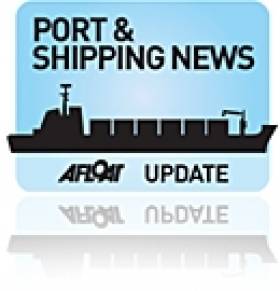Displaying items by tag: Cruiseliners
Capital Dredging Campaign Underway Between Dublin Port And Bay
A dredging campaign for this year is currently underway as the Dublin Port Company was granted a loading and dumping permit at sea, writes Jehan Ashmore.
Back in September 2016, a Dumping at Sea Permit was issued to DPC by the Environmental Protection Agency. The permit from the EPA allows for the continued loading and dumping at sea of dredged material arising from a capital dredging campaign as part of the Alexandra Basin Redevelopment (ABR) Project.
In addition the ABR includes the ability to accommodate the largest cruise liners based from a proposal to incorporate such new berths.
This day last week a Cruise Consultation was launched by DBC for the views of the public and stakeholders alike to be engaged in the redevelopment among them the proposed cruise-berths located at the North Wall Quay Extension.
Such cruise berths would be sited on the seaward side (as pictured) of the Tom Clarke (East-Link) Bridge. Construction of the berths is scheduled to begin in 2024 and be completed in readiness for the 2026 cruise season.
In the meantime, a Cypriot flagged trailing suction hopper dredger, Freeway,which carried out works in Dublin Bay for last year's campaign, returned last week to the port. Dredging operations are due to be completed by March 2020.
Irish Dredging Co. Ltd., which is a company within the Dutch based Boskalis Group, was the appointed contractor by Dublin Port. This sees Freeway, fourth in a series of 4,500m3 capacity hopper dredgers, carry out such duties between the port and out into Dublin Bay close to the Burford Bank.
Built in 2015 by Shipkits of Groningen, Freeway's design allows for operations conducted in shallow waters, for maintenance tasks within ports in addition coastal protection projects.
In Cork Harbour the town of Cobh is bracing itself for the arrival of some 1,500 Australians ahead of the town's annual 'Australia Day' celebrations.
The cruiseship Sea Princess, EchoLive.ie writes, will be making a pitstop in Cork Harbour on July 11 as part of its 107-day round-the-world cruise.
Cobh, which was recently named one of the 25 most beautiful towns in Europe by Conde Nast, will be just one of the 36 ports it visits on the 59,000km journey. The event will be marked with festivities and christened ‘Australia Day in Cobh.’ It will include festivities to mark the special occasion including Irish dancing, market stalls and a performance from trad band Gaelic Brew on the bandstand.
Passengers will later be treated to a musical farewell from Cobh Confraternity Band.
For more including the role of the Australian Ambassador to Ireland click here.
#dublinport - Dublin Port Company issued a statement this week in regards to its cruise ship business which showed the number calling to the Port has grown considerably in recent years.
In 2018, there were 150 cruise ship calls. This year there will be over 160 and, for 2020, there are 140 bookings already.
Because of the huge growth in cargo volumes (36% in the six years to 2018) and the impact of the major programme of capital works in Dublin Port (€1 billion from 2019 to 2028) it is necessary for Dublin Port Company (DPC) to introduce a system to better balance the allocation of berths for essential year-round cargo services and for seasonal cruise ships.
Since the 1980s, Dublin Port has provided considerable financial support from its own resources to develop cruise tourism to the capital.
From 2021, berth allocations for cruise ships in Dublin Port will be managed in accordance with a new Cruise ship berthing policy and pricing from 2019 to 2021 (click to download).
The effect of this new policy will be to restrict the annual number of cruise ships in Dublin Port to about 80 starting in 2021. This is the same level of cruise ship activity in Dublin Port in 2010.
If Dublin Port is to cater for large numbers of cruise ships (in excess of 200) in the future, new berths will have to be constructed at North Wall Quay Extension (see photo), adjacent to the Tom Clark Bridge. This will require co-financing and / or long-term financial guarantees from cruise lines.
This requirement for part-funding is set out in Dublin Port’s Masterplan 2040.
Long-term Cruise Capacity
DPC has commissioned an economic cost benefit analysis from Indecon / Bermello Ajamil. This is due to be completed by mid-year. Based on this analysis, DPC will engage with stakeholders to determine their willingness to support the required investment.
Cruiseships Large & Small Visit Competing Dublin Bay Ports on Day of Casting of the Spear
#CruiseDublinBay – Two cruiseships one large the other small, yesterday visited separately Dublin Port and Dun Laoghaire Harbour, the later destination welcoming its first caller this year, writes Jehan Ashmore.
Princess Cruises 3,082 passenger capacity Emerald Princess (2007/118,681grt) docked in Dublin, having sailed from Cork overnight while Island Sky (1992/4,200grt) called to Dun Loaghaire after also picked up a pilot in the bay having sailed from Waterford city-centre.
The Noble Caledonia operated Island Sky is on a 'Gardening' themed cruise with 87 passengers out of a 114 total capacity, making visits of spectacular gardens in bloom and earlier today she docked in Holyhead.
Meanwhile, Emerald Princess is heading through the English Channel this evening in the busy shipping lane off Alderney and understood to be bound for Zeebrugge, Belgium.
Emerald Princess call to Dublin Port involved her berth at Ocean Pier west, which is close to the proposed €30m cruise terminal that forms part of the €200m Alexandra Basin Redevelopment (ABR) Project. This year the port is scheduled for around 90 callers.
Further upriver along Sir John Rogerson Quay, St. Bridget of Dublin Bay Cruises was moored at her berth opposite the Convention Centre. The landmark is an easy reference point to where passengers board and disembark on excursions to Howth, Dun Laoghaire and from that harbour a late afternoon cruise is offered to Killiney Bay.
On the Liffey, the shipping scene yesterday notably focused on the sheer presence of Emerald Princess which could be seen in the distance downriver, even before St. Bridget set off on a special short cruise through the East-Link bridge and beyond to the port channel.
In a becalmed sea, Lord Mayor of Dublin, Oisin Quinn was kept busy having launched a new Dublin – Land & Sea ticket in conjunction with Dublin Bus Tours followed by a photocall for a Dublin based councillor as a candidate of the forthcoming European elections. Not to mention the honorary role of the mayor as Admiral of Dublin Port, where such duties were performed for the annual tradition of 'casting of the spear'.
The ceremonial tradition dates back to 1488 when Lord Mayor, Thomas Mayler, according to historical records set out on his horse to ride across the strand and to cast the spear and from wherever it landed marked the city's boundaries.
Looking across the present day strand of south Dublin Bay, is the structure of Dun Laoghaire Harbour with its fine piers jutting into the sea from where the Island Sky arrived into port, the first of four to call this season.
Among them is another newcomer, Seabourn Legend of the luxury Seabourn Cruises fleet of large private yacht-like ships. She is due to call in August.
Likewise of Dublin Port, the Dun Laoghaire Harbour Company, also propose a dedicated cruise terminal costing €17m, so to handle even larger vessels such as Emerald Princess, in which the capital port have also factored into in terms of their terminal design plans.
Polar Cruiseship Launches London-Derry Port Season
#CruiseNorthWest – Polar cruiseship Fram, a Norwegian-flagged 418 passenger vessel operated by Hurtigruten, became the first visitor this season having docked in Londonderry today, writes Jehan Ashmore.
Fram which has a rather stout looking appearance measuring 114m long, had arrived from Stornoway, Isle of Lewis of the Outer Hebrides. She also presents a striking livery with her black hull separated from her white superstructure by a bold red band.
This colour scheme applies to her fleetmates that are not cruiseships but are essentially multi-purpose vessels that perform the role of carferry, cruiseship and cargo-carrying that 'Hurtigruten' operate daily sailings between Bergen and Kirkenes beyond the Arctic Circle and close to the Russian border.
Fram represents the cruise industry sector to the north-west port which is to welcome a further four callers this season. She is the only cruiseship to berth along the quays of Londonderry, where she docked at the city centre berth.
Two medium sized cruiseships, Delphin and Seabourn Legend are to berth downriver at Lisahally on the east side of Lough Foyle, while on the west coast, off Greencastle, Co. Donegal, the larger Adonia and Crystal Symphony are to make anchorage calls.
Since 1995, Londonderry Port has opened up for business in attracting cruiseships, and among this year's operators are P&O Cruises and Seabourn.
In total more than 4,000 passengers and crew are to visit the city which has hosted in recent years prestigious sailing events, maritime festivals and the high-profile Derry-Londonderry European City of Culture in 2013. This year the city looks forward to Music City 2014.
Discovering Belfast Harbour’s Cruiseship Potential
#CruiseBelfast – Discovery is to open the Belfast Harbour cruise season in late March with up to 750 passengers calling to the port out of a total of 110,000 visitors expected this year, writes Jehan Ashmore.
In 2013, Belfast Harbour handled around 60 cruiseships, a record for the port that represented a 45% jump in passengers and crew, up from 75,000 to 110,000 in just one year. It was estimated the associated spend generated more than £18m for the local economy and in opening up Northern Ireland in general as a visitor destination.
Once again, many of the leading cruise operator brands are calling to the harbour in 2014, among them; Princess Cruises, Holland America Line, Celebrity, MSC, Thomson, Fred Olsen Cruise Line and Saga Cruises. In addition the port is to welcome several cruise callers for the first time, they are the FTI Berlin, Kristina Katarina, Louis Aura and the sail-assisted Club Med 2.
As previously reported, Belfast Harbour is building the first purpose-built cruise terminal in Ireland, which is to attract a wider global audience of cruise passengers using the £7m facility which is due for completion this year. Cruise ships will then transfer from Stormont Wharf in Co. Antrim, the main existing berth on the north side of the Lagan to the opposite bank adjacent to Alexandra Dock in Co. Down.
The new terminal, to include a 2.5 acre area for coaches and a welcome centre to showcase Northern Ireland, will also be within walking distance of Titanic visitor attractions - Titanic's Dock & Pumphouse, Titanic Belfast, SS Nomadic and the WWI battle-cruiser HMS Caroline which is to undergo restoration work.
The facility will handle all cruise ships currently visiting Irish Sea ports but is also designed to cater for 'next generation ships' capable of accommodating 4,500 passengers and crew.
Dun Laoghaire County Manager Seeks Funding Approval to Development of New Super-Cruiser Berths
#CruiseLiners – The Irish Times reports that the outgoing county manager of Dún Laoghaire Rathdown County Council is to seek approval to spend more than €7 million on various projects among them the development of berthing facilities for super-cruisers in Dún Laoghaire Harbour.
Owen Keegan, who will take up his new post as Dublin city manager on Tuesday, will seek to cement his seven-year legacy in the county by ensuring funding for certain projects is secured before his departure on the preceeding Monday.
In a report to Dún Laoghaire councillors in advance of Monday's meeting, Mr Keegan said 12 cruisers had called at Dún Laoghaire this year, bringing 27,000 visitors, and Irish ports had attracted 220 cruise calls in 2012. But Dublin was missing out because neither the city's port nor Dún Laoghaire could accept ships of more than 300m in length.
The council had been assisting Dún Laoghaire Harbour Company in developing the port as a destination for cruise ships, he said, and the next stage would involve developing plans for a new cruise facility and applying directly to An Bord Pleanála for planning permission through the strategic infrastructure development process.
The cost of the plan is €650,000 and Mr Keegan is to seek approval for the council to contribute €250,000.
Foynes Port Welcomes First Cruiseship Caller of the Season
#CruiseshipFoynes- Foynes Port today welcomed its first cruise-caller Prinsendam of the Holland America Line, writes Jehan Ashmore.
The 700 passenger vessel is on a 14-night cruise of British and Irish Ports having departed Amsterdam. Yesterday, the 38,848grt cruiseship had sailed overnight from an anchorage call off Galway Harbour.
One of the main visitor attractions is the Foynes Flying Boat Musuem. Earlier this year the visitor centre added a new Maritime Museum dedicated to the role of shipping between the Mouth of the Shannon and right up the estuary to Limerick Docks.
Originally, Voyages of Discovery's 15,396 tonnes Voyager was to be the first cruise caller to the estuary port. As previously reported, the ship had generator problems which prevented the vessel in making a call in late May.
Prinsendam is to depart this evening bound for Waterford Port. The next and only caller to Foynes this season is Pheonix Reisen's Amadea which is due in mid-September.
Foynes is one of six port facilities along the estuary operated by Shannon Foynes Port Company (SFPC) which posted a record operating profit of just over €3 million for 2012.
Port of Cork All Set for Australia Day in Cobh
#SydneyWorldCruise – Tomorrow is Australia Day and the Port of Cork will welcome up to 1500 from Down Under as well as 400 Kiwis to Cobh as part of their Sydney to Sydney World Cruise on board Princess Cruises Sea Princess.
As the passengers step ashore from the 77,499 tonnes vessel's maiden voyage to Cobh, they are sure to receive a very warm Irish welcome as Cobh Tourism presents Australia Day with the weather forecast to match.
In the morning when Sea Princess arrives there will be a formal port welcome on board to the Captain attended by Port Management and the Australian Ambassador to Ireland Dr. Ruth Adler.
Following this, there will be a civic welcome ashore with the Captain and Cruise Director of Sea Princess and the Australian Ambassador at 11.30 am in Cobh Heritage Centre, adjacent to the quayside.
With such a rich and poignant history of emigration from the Port of Cork, particularly from Cobh (formerly Queenstown) to Australia, this "special Irish Australia Day" will not only mark the visit of this spectacular cruise liner but will also remind visitors of the thousands who left or were deported from Ireland bound for a life down under. With this in mind, a "Blessing of the Bonnets" ceremony will take place in memory of all convict women transported from Ireland to Australia.
Captain Michael McCarthy, Commercial Manager Port of Cork has for some time being working with Princess Cruises to secure the call of Sea Princess on her world cruise. With so many Australian roots here, the Port of Cork was thrilled when they received confirmation that the World schedule included Cobh.
Of the 60 cruise liners calling to the Port of Cork in 2013, 11 vessels carry the very distinctive brand of Princess Cruises and they alone will bring over 30,000 visitors to Cork Harbour and its regional attractions. In addition, August is set to be one of the busiest months on record for the port, with 21 liners calling.
With so much happening in Cobh on Sunday, cruise passengers and visitors to Cobh are set to have a fantastic day with local traditional music and dance, fascinating Australian themed shop window displays, sizzling barbecues, food stalls and local arts and crafts stalls on display.
A performance by the Band 1 Southern Brigade will take place at 2.30 pm in the town park and will be followed by more local entertainers. Captain McCarthy stated that "the tremendous work undertaken by Cobh Tourism and the team spirit of all organisations and Councils working together has put Cobh and the entire Cork region a "must see destination" on the cruise companies calendar.
The Cobh Confraternity Brass and Reed Band will play on the quayside as the Sea Princess sails to continue its 104 night odyssey around the World.
Will the traditional "Anchors Aweigh" be replaced by "Tie Me Kangaroo down Sport" as 2000 happy passengers are given a traditional Cobh farewell with white handkerchiefs and Australian and Irish flags waving.
#ShippingReview – Over the last fortnight, Jehan Ashmore has reported from the shipping scene, where Minister for Transport Leo Varadkar, launched the National Ports Policy which is to radically overhaul commercial ports and the transfer of 'regional' ports to local authorities.
Among the proposed regional ports is Dun Laoghaire, where the harbour which is in the middle of the town is expected to focus on tourism, cruise liners and marine leisure activity.
In regards to larger strategic ports, (noting Port of Cork development update) they are charged with leading the response to national capacity requirements, something that is long overdue because port capacity has not been matching growth in traffic for either unitised and non–unitised cargo.
The policy follows the launch of a 30–year masterplan for Dublin Port Company over a year ago and the launch of the Shannon Estuary masterplan announced in February.
Responding to the National Ports Policy, the Irish Ports Association (IPA) which is the representative body for the Irish ports sector and an affiliate of IBEC welcomed the publication which sets out the policy framework for the future development of the sector.
Amidst snow flurries and gusts up to 34 knots, the cargoship Blue Tune departed Dun Laoghaire Harbour having discharged the final round of fermentation tanks bound for Guinness's St. James's Gate Brewery in central Dublin.
The Antigua and Bermuda flagged vessel, was the third such ship to dock in Dun Laoghaire Harbour since mid-February and the return of cargo ships marks a trade not seen in the port for more than two decades.


























